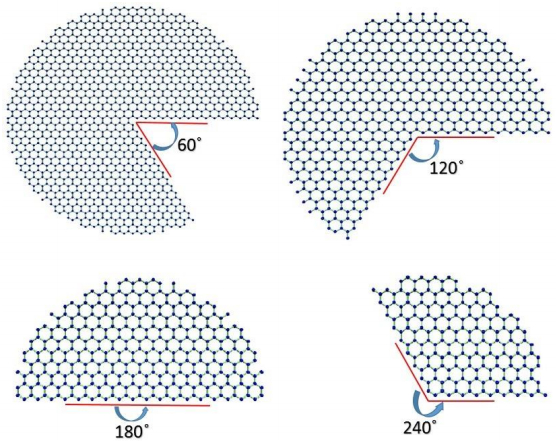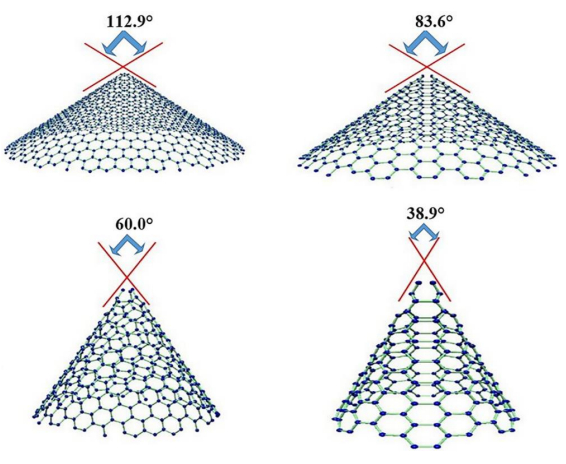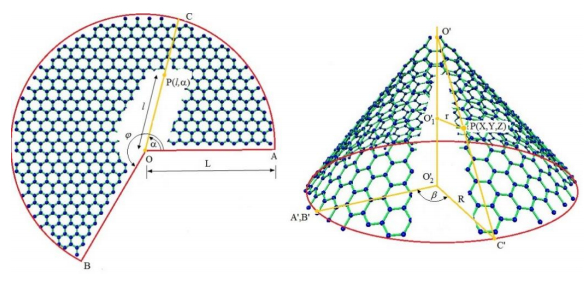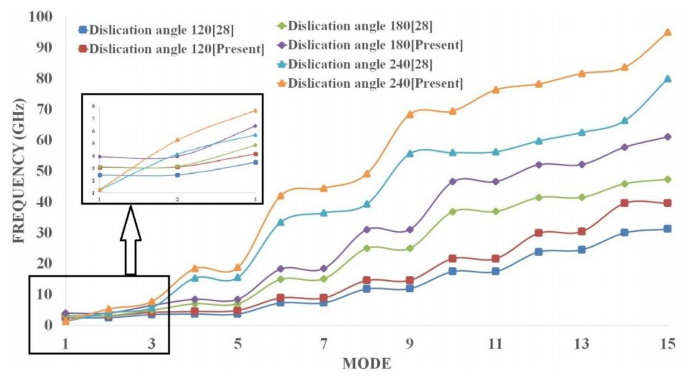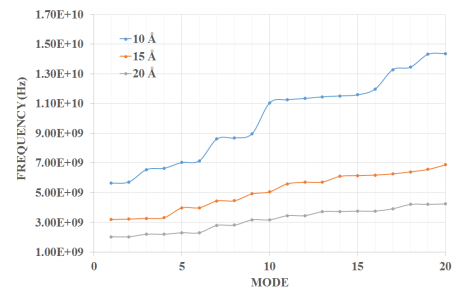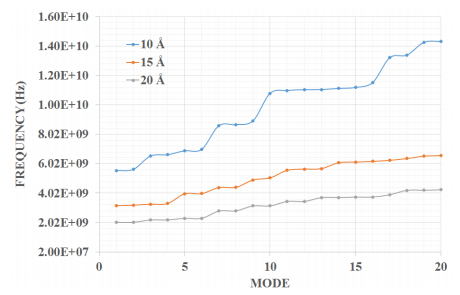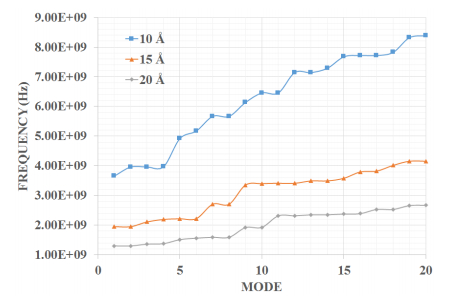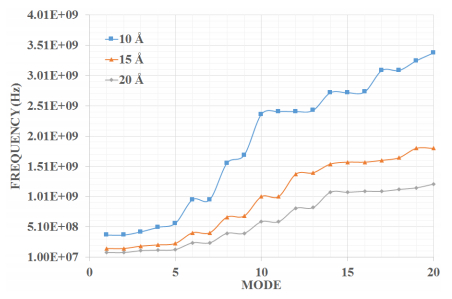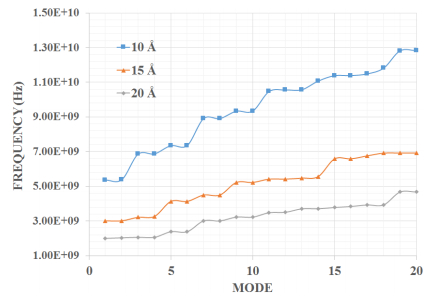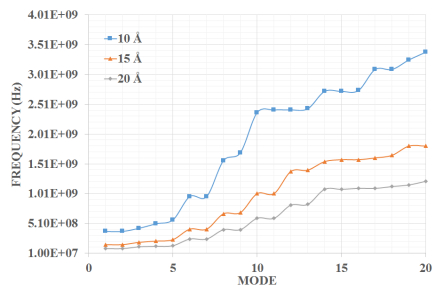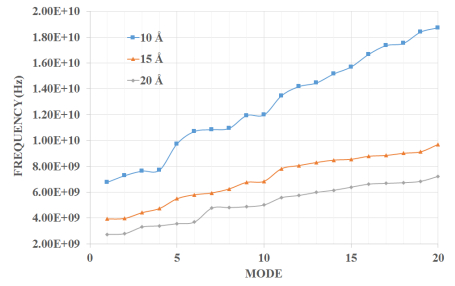In the present manuscript an approach to modelling and simulation of nanocones has been suggested for their use as sensing mediums. The vibrational behaviours of bridged and cantilever Single-Walled Carbon nanocones are modelled using three-dimensional elastic beams of carbon- carbon bonds and atomic masses. Also, the dynamic analysis of bridged and cantilever configurations of these nanocones with different disclination angles of 60°, 120°, 180°, and 240° is performed to evaluate the variation in stiffness with different configurations. The analysis also exhibits the effect of change in the length of nanocones on the vibrational frequencies. For the said purpose a mass equivalent to a carbon atom has been added at the nodes. It is observed that increasing side length of a Single-Walled Carbon nanocones with a constant apex angle results in a reduction in the fundamental frequency. It is also clear from the results that Single-Walled Carbon nanocones with larger apex angles exhibit smaller values of fundamental frequencies. The results suggest that smaller lengths of nanocones are better candidates for sensing applications as they exhibit substantial change in the fundamental frequencies. It can be stated that with higher number of bonds and atoms Single-Walled Carbon nanocones undergoes substantial bending with large declination angle which can be considered as an important finding.
1.
Introduction
1.1. Ostrowski type inequalities
In 1938, A. M. Ostrowski introduced the subsequent appealing integral-based inequality to relate the value of a function Ψ with its integral from α to β:
Consider Ψ:[α,β]→R is continuous on [α,β] and differentiable in (α,β), such that Ψ′:(α,β)→R is bounded in (α,β), i.e. ‖Ψ′‖∞:=supˆa∈(α,β)|Ψ′(ˆa)|<∞. Subsequently for any ˆa∈[α,β], we have:
If the fraction 14 cannot be substituted by any smaller value then it leads to sharpness of the above inequality.
Afterward, several researchers have brought in few findings through the extensions and generalizations of Inequality (1.1). Such inequalities can be employed to guesstimate the inaccuracy of approximation in integration while investigating the steadiness and consistency of statistical calculation [1].
Stefan Hilger [2] developed the calculus of measure chains in 1988. His Ph.D. supervisor Bernd Aulbach described core contributions of this theory of Unification, Extension and Discretization. The concept of time scales is a novelty in applied sciences as well as in mathematics as it enlightens a number of indefinite points about differential equations and solutions of some fractional order differential equations, which have been proved to be inadequate for their solution. Additionally, it has enlarged its contribution to the literature with its applications in areas such as engineering, biostatistics, mathematical biology, functional spaces, optimization theory and dynamic inequalities. The theory of time scales has attracted a great attention of researchers for resolving many problems in analysis. Some dynamical inequalities on time scales can be found in [3,4,5], where researchers established convex function-based inequalities, new Hardy-type inequalities and inequalities for product of different kinds of convex functions respectively using various analytical and theoretical approach on time scales. Furthermore Hu & Wang [6] discussed dynamic inequalities on time scales with applications in permanence of predator-prey system and Saker [7] employed some dynamic inequalities of Opial-type on time scales to prove numerous results related to the spacing between successive zeros of a solution of a second order dynamic equation with a damping term. Bohner and Matthews ([8,Theorem 3.5]) characterized the following relation on Γ as a generalization of the Ostrowski Inequality (1.1) :
Let α,β,ˆu,ˆv∈Γ,α<β, and Ψ:[α,β]∩Γ=[α,β]Γ→R is differentiable. Then we have the inequality:
where M=supα<ˆv<β|ΨΔ(ˆv)|<∞ and [α,β]Γ is a closed interval under Γ. If its R.H.S of Inequality (1.1) cannot be substituted by any smaller value then it leads to sharpness of the above inequality.
Liu & Ngô ([9,Lemma 3.2]) proved the following identity: Let α,β,ˆu,ˆv∈Γ,α<β and Ψ:[α,β]Γ→R is differentiable. Then the following relation for all η∈[0,1] holds.
where,
By making use of (1.2), they have expanded the Inequality (1.1) by considering parameter η and developed the following Ostrowski type inequality involving parameter η ([9,Theorem 3.1]):
Let α,β,ˆu,ˆv∈Γ,α<β, and that Ψ:[α,β]Γ→R is differentiable function. Then the following relation holds true:
for all η∈[0,1], such that α+ηβ−α2 and β−ηβ−α2 are in Γ where ˆv∈[α+ηβ−α2,β−ηβ−α2]∩Γ, and M=supα<ˆv<β|ΨΔ(ˆv)|<∞. Its sharpness is conditioned with
Here [α,β]Γ represents a closed interval on Γ.
Xu & Fang [10,Lemma 1] investigated the following identity: Let α,β,ˆu,ˆv∈Γ,α<β,Ψ:[α,β]Γ→R is differentiable, and ζ:[0,1]→[0,1] is given, then we have
where
By making use of (1.4), they proved Ostrowski Inequality [10,Theorem 1] by using a parametric function and developed the result:
Let α,β,ˆu,ˆv∈Γ,α<β,Ψ:[α,β]Γ→R is differentiable, and ζ:[0,1]→[0,1], then
for all η∈[0,1] such that α1 and α2 are in Γ, and t∈[α1,α2]∩Γ, where M=supα<ˆv<β|ΨΔ(ˆv)|<∞. Its sharpness is conditioned with
We refer [11,12,13] for detail textual-cum-mathematical description on the weighted Ostrowski type inequalities (wOTIs) via time scales. Such as Liu, Tuna and Jiang [11] developed few wOTIs by using weighted Montgomery identity on Γ. Liu and Tuna [13] characterized wOTIs on Γ by utilizing the concept of combined dynamic derivatives on Γ. Several scholars investigated multivariate OTIs on Γ in [14,15,16]. Few authors [17,18,19,20,21,22,23,24,25,26,27,28] utilized various methods to develop OTIs on Γ for functions of two variables. Motivated by the mentioned work, we extend OTIs for bivariate functions, which can be considered as generalizations of OTIs proved by Liu & Ngô, Xu & Fang and by Dragomir et al. [29].
1.2. Essentials on time scales
(1) Time scale: It is a closed subset of the real numbers. In present study, it is denoted by the symbol Γ. Examples of time scales include Cantor set, closed intervals, Z.
(2) Forward jump operator: For t∈Γ, the Forward jump operator ρ:Γ→Γ is defined as
(3) Γk notation:
(4) Ψσ notation: If Ψ:Γ→R is a function, then we define a function Ψσ:Γ→R by
i.e., Ψσ=Ψ∘σ.
(5) rd-continuous function: A function ζ:Γ→R is stated as rd-continuous if it is continuous and its left-sided limits exist at right-dense points and left dense points respectively in Γ. The symbol Crd stands for the family of all such functions.
(6) The delta derivative: Let Ψ:Γ→R with ˆv∈Γk. The term ΨΔ(ˆv) is said to be a number (if exists) if for any ϵ>0, ∃ a neighbourhood U of ˆv (i.e., U=(ˆv−δ,ˆv+δ)∩Γ for any δ>0) such that
The value ΨΔ(ˆv) is known as the delta (or Hilger) derivative of Ψ at ˆv. Furthermore, the function Ψ is said to be delta differentiable on Γk if ΨΔ(ˆv) exists ∀ˆv∈Γk.
(7) Integration by parts: If α,β∈Γ and Ψ,ζ∈Crd then
or
(8) Polynomials on time scales: The generalized polynomials are the functions ζk,Ωk:Γ2→R,k∈N0, defined recursively as follow: the functions Ω0 and ζ0 are ζ0(ˆv,ˆu)=Ω0(ˆv,ˆu)=1 for all ˆu,ˆv∈Γ, and, for given ζk and Ωk with k∈N0, the functions ζk+1 and Ωk+1 are ζk+1(ˆv,ˆu)=ˆv∫ˆuζk(σ(τ),ˆu)Δτ, for all ˆu,ˆv∈Γ and Ωk+1(ˆv,ˆu)=ˆv∫ˆuΩk(τ,ˆu)Δτ for all ˆu,ˆv∈Γ. If ΩΔk(ˆv,ˆu) represents the derivative of Ωk(ˆv,ˆu) w.r.t. ˆv for any ˆu, then ΩΔk(ˆv,ˆu)=Ωk−1(ˆv,ˆu),∀k∈N,ˆv∈Γk. Similarly ζΔk(ˆv,ˆu)=ζk−1(σ(ˆv),ˆu)∀k∈N,ˆv∈Γk.
For further study of time scale calculus, readers are referred to [30,31].
Note: In this article, several abbreviations are used in order to lighten the notation and shorten the proofs; we refer to the table at the end just after the section of conclusions. Moreover throughout the paper we consider [a,b]Γ=[a,b]∩Γ.
2.
Main results
This section presents the characterization of novel wOTIs on Γ through the generalization of Montgomery identity with parameter functions.
2.1. Generalized Montgomery identity for parametric function ζ(η)
Lemma 2.1. Let α,β,γ,θ,ˆu,ˆv∈Γ with α<β,γ<θ,Ψ:I=[α,β]Γ1×[γ,θ]Γ2→R is differentiable. Assume that the delta derivatives ΨΔΔ(ˆv,ˆu) exist on I and ζ:[0,1]→[0,1]. Then we have the following identity
where
Proof. Since
Denote
By using (1.6), we integrate I2 to get
Similarly
By using I2 and I3 in (2.3), we have
Use I1 in (2.2) to find
where I4=β∫αk1(ˆx,ˆv)ΨΔ(ˆv,ˆy)Δˆv, I5=β∫αk1(ˆx,ˆv)ΨΔ(ˆv,γ)Δˆv and I6=β∫αk1(ˆx,ˆv)ΨΔ(ˆv,θ)Δˆv.
Now,
Use (1.6) to find
In similar fashion,
By adding I7 and I8, we have
Similar calculations for I5 and I6 give
and
Using I4, I5 and I6 in (2.4), we have
Simplification yields
Remark 2.1. If Ψ is single valued function then Eq (2.1) coincides with [10,Lemma 1].
Corollary 2.1. Let α,β,γ,θ,ˆu,ˆv∈Γ with α<β,γ<θ,Ψ:I=[α,β]Γ1×[γ,θ]Γ2→R is differentiable. Assume that the delta derivatives ΨΔΔ(ˆv,ˆu) exist on I and η∈[0,1]. We then have the equation
where
Proof. If we choose ζ(η)=η in Lemma 2.1, we get the required estimate.
Remark 2.2. If Ψ is single valued function then Eq (2.6) coincides with [9,Lemma 3.2].
2.2. Generalized Ostrowski inequality for parameter function ζ(η)
Theorem 2.1. Suppose that α,β,γ,θ,ˆu,ˆv∈Γ with α<β,γ<θ,Ψ:I=[α,β]Γ1×[γ,θ]Γ2→R is differentiable. Assume that the delta derivatives ΨΔΔ(ˆv,ˆu) exist on I and ζ:[0,1]→[0,1]. We then have the inequality
for all η∈[0,1] such that α1 and α2 are in Γ1, and ˆx∈[α,β]∩Γ1, γ1 and γ2 are in Γ2, ˆy∈[γ,θ]∩Γ2, where M1=Supα<ˆv<βγ<ˆu<θ|ΨΔΔ(ˆv,ˆu)|<∞, M2=Supα<ˆv<βγ<ˆu<θ|ΨΔσ(ˆv,ˆu)|<∞ and M:=Max{M1,M2}.
Proof. By taking absolute value on both sides of (2.1), one yields
Further we have to use |Ψ+ζ|≤|Ψ|+|ζ|, |β∫αΨdˆx|≤β∫α|Ψ|dˆx & |ΨΔσ(ˆv,ˆu)|≤M;|ΨΔΔ(ˆv,ˆu)|≤M;|Ψ.ζ|=|Ψ||ζ| toestimate as following:
Simplifications give the required result.
Corollary 2.2. If all the assumptions of Corollary 2.1 hold, then we find the following Ostrowski type inequality for parameter η
Proof. The proof is similar to proof of Theorem 2.1.
Remark 2.3. The inequality (2.8) can be considered as extension of [9,Theorem 3.1]. Since if Ψ is single valued in (2.8), we get [9,Theorem 3.1].
Corollary 2.3. Under the assumptions of Theorem 2.1, we have the following Ostrowski type inequality:
Proof. Take ζ(η)=η2 in Theorem 2.1 to meet the requirement.
Remark 2.4. The following Ostrowski type inequalities are obtained by choosing η=0,η=12 and η=1 in Corollary 2.3 respectively:
(a) |Ψ(ˆx,ˆy)−1β−αβ∫α{Ψσ(ˆv,ˆy)+Ψσ(ˆv,γ)+Ψσ(ˆv,θ)}Δˆv|≤ M(β−α)(θ−γ){Ω2(ˆx,α)+Ω2(ˆx,β)}[(θ−γ)+Ω2(ˆy,γ)+Ω2(ˆy,θ)].
(b) |Ψ(ˆx,ˆy)+14{Ψ(α,ˆy)+Ψ(ˆx,γ)}+34{Ψ(β,ˆy)+Ψ(ˆx,θ)}+116Ψ(α,γ)+316{Ψ(β,γ)+Ψ(α,θ)}+916Ψ(β,θ)−4β−αβ∫α{Ψσ(ˆv,ˆy)+Ψσ(ˆv,γ)+Ψσ(ˆv,θ)}Δˆv|≤4M(β−α)(θ−γ)
(c) |Ψ(α,γ)+Ψ(β,γ)+Ψ(α,θ)+Ψ(β,θ)−4β−αβ∫α{Ψσ(ˆv,ˆy)+Ψσ(ˆv,γ)+Ψσ(ˆv,θ)}Δˆv|≤4M(β−α)(θ−γ)
2.3. Generalized Montgomery identity involving parametric functions ζ1(η) and ζ2(μ)
Lemma 2.2. Let α,β,γ,θ,ˆu,ˆv∈Γ with α<β,γ<θ,Ψ:I=[α,β]Γ1×[γ,θ]Γ2→R is differentiable. Assume that the delta derivatives ΨΔΔ(ˆv,ˆu) exist on I and ζ1,ζ2:[0,1]→[0,1]. We then have the equation
where
Proof. It can easily be proved by following the steps of Lemma 2.1.
Remark 2.5. If ζ1(η) = ζ2(μ) in Lemma 2.2, it becomes Lemma 2.1.
2.4. Generalized Ostrowski type inequalities involving parametric functions ζ1(η) and ζ2(μ)
Theorem 2.2. Suppose that α,β,γ,θ,ˆu,ˆv∈Γ with α<β,γ<θ,Ψ:I=[α,β]Γ1×[γ,θ]Γ2→R is differentiable. Assume that the delta derivatives ΨΔΔ(ˆv,ˆu) exist on I and ζ1,ζ2:[0,1]→[0,1]. We then have the inequality
Proof. By using Lemma 2.2 and adopting the technique of proof of Theorem 2.1, we get the desired result.
Remark 2.6. In similar fashion, remaining results of Section 2.2 can be extended for (2.11).
3.
Applications to some particular time scales
Some important examples of time scales include continuous time scale Γ=R (set of all real numbers, which gives rise to differential equations), discrete time scale Z (set of integers, which gives rise to difference equations) and quantum time Scale qN0,q>1. In this section we have discussed Ostrowski type Inequality (2.8) for these special time scales.
Example 3.1. If we take Γ1=Γ2=R, then the delta integral is the usual Riemann integral i.e. β∫αΨσ(ˆv)Δˆv=β∫αΨ(ˆv)dˆv as σ(ˆv)=ˆv. In this case, the generalized polynomial Ω2 is
which implies the following relations:
The Eq (2.8) takes the following form
Remark 3.1. If Ψ is single valued function then assumptions and calculations made in Example 3.1 coincide with [29,Theorem 2].
Example 3.2. Using Γ1=Γ2=Z,α=0=γ,β=n,θ=m,s=j,t=i,Ψ(p,q)=ˆxpˆyq,p=k,q=l and Ψσ(p,q)=σ(ˆxpˆyq)=ˆxp+1ˆyq+1; β∫αΨσ(ˆv,θ)Δˆv=4nn−1∑t=0ˆxt+1ˆym in Eq (2.8), with the known result
we have
Example 3.3. If we take Γ1=Γ2=qN0,q>1,α=γ=qm,β=θ=qn,m<n,η=1 in Eq (2.8), we have
Remark 3.2. If Ψ is single valued then Example 3.1 to Example 3.3 coincide with [9,Corollaries 3.6–3.8]. Furthermore, it is also possible to reset Eq (2.7) instead of Eq (2.8) for these particular time scales, which will be extensions of [10,Corollary 1,2] in case of continuous and discrete time scales.
4.
Conclusions
In this study, a novel approach is employed for the establishment of Ostrowski type integral inequalities for double integrals via Montgomery identity under the setting of time scales calculus. In addition, certain generalizations are made for some weighted and parameterized functions. Moreover, some particular cases, applications and examples are discussed for some specific time scales. It is also worth mentioning that the results of the paper extend the results of [9,10,29]. Further extensions can be sought by the expansion of this proposed study for multiple integrals.
Notations
Following notations have been used in the paper for vivid understanding of the concept:
Acknowledgments
This research received funding support from the NSRF via the Program Management Unit for Human Resources and Institutional Development, Research and Innovation (grant number B05F640088).
Conflict of interest
The authors declare that there is no conflict of interests regarding the publication of this paper.









 DownLoad:
DownLoad:


